Content
- 1 Early varieties of bell peppers for outdoor use
- 2 Mid-season
- 3 Sweet pepper for Siberia
- 4 Varieties for the Moscow region
- 5 The best hybrid varieties
- 6 Description of the best late-ripening peppers
- 7 Thick-walled large-fruited varieties
- 8 The best peppers for stuffing and processing
- 9 Conclusion
- 10 What is the difference between a hybrid and a cultivar?
- 11 The best varieties of sweet peppers
- 12 The best varieties of peppers for 2018
- 13 New varieties and hybrids of pepper seeds
- 14 How to grow peppers: infographic
- 15 1. Apricot favorite
- 16 2. Agapovsky
- 17 3. Atlant F1
- 18 4. Belladonna F1
- 19 5. Bogatyr
- 20 6. Star of the East chocolate F1
- 21 7. Isabella F1
- 22 8. California miracle
- 23 9. Cardinal F1
- 24 10. Swallow
Bell peppers are a thermophilic annual plant originating in America. Prized for its unique taste and high vitamin content... In the article we will consider early, mid- and late-ripening varieties, talk about hybrids, and offer varieties for stuffing.
Early varieties of bell peppers for outdoor use
The early varieties are called allowing for a short period of time (70-120 days) to get a high yield... Most species can be grown in unprotected soil. Description and characteristics of the best varieties are presented below.
Big Mama
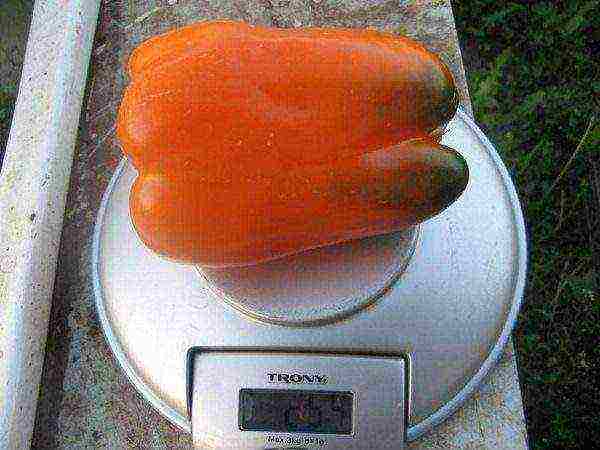 Early variety of Big Mama pepper
Early variety of Big Mama pepper
Fruits are large (200g) of warm orange rectangular shape. A bush in a greenhouse can grow up to 1 m, in unprotected ground - 50-70 cm... Excellent taste both fresh and after heat treatment.
Merchant
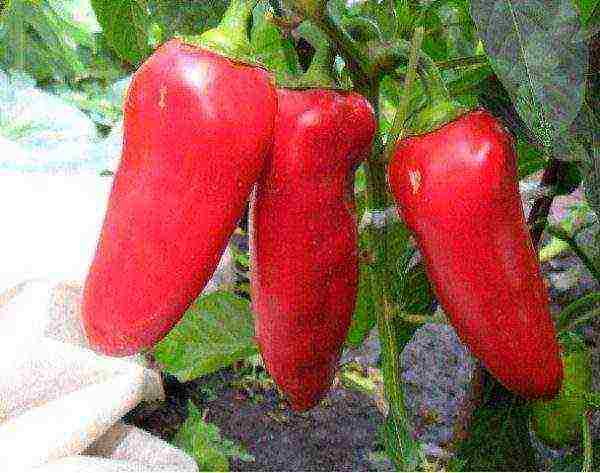 Sweet pepper grade Kupets
Sweet pepper grade Kupets
Medium-sized plant with pyramid-shaped fruits. During biological maturation, they are dark red in color, with a juicy dense pulp.... Peppers are large-fruited, thick-walled.
Mid-season
The varieties of medium ripeness include those the growing season of which occurs in the range from 110 to 130 days... This species is distinguished by the duration of fruiting.
Martin
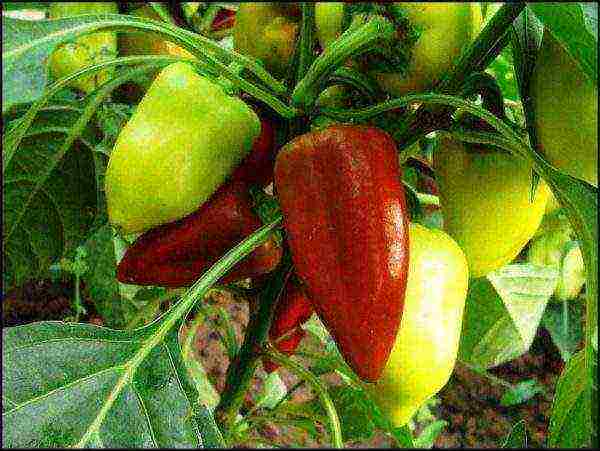 Sweet pepper swallow
Sweet pepper swallow
A variety with high seed germination. Fruits are cone-shaped, red. Length of ripe pepper Swallow up to 10 cm... The bush is small, about 50 cm.
Atlant
 Tall variety Atlant pepper
Tall variety Atlant pepper
A tall variety with a fairly large yield. Atlant fruits are large (400g), sweet, deep red, thick-walled (1 cm). Peppers grow up to 20 cm in length... Disease resistant.
Sweet pepper for Siberia
Sweet peppers come from hot countries, they like the warm temperate climate. But even in such a harsh region as Siberia, you can grow peppers and get an excellent harvest. There are many varieties for the colder climates. Which ones to use in the area? Summer in Siberia is short, so it is better to use early or mid-early peppers. The most common among them are the following:
Dandy
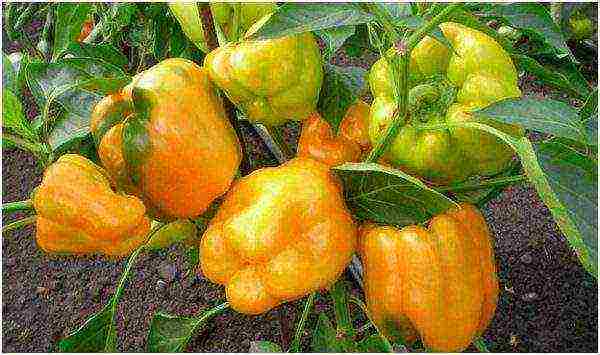 Pepper grade Goldfinch
Pepper grade Goldfinch
An early variety with a low bush (up to 50 cm). The vegetables are cylindrical, dark yellow when ripe... The thickness of the pulp is 5-8 mm.
Moneybags
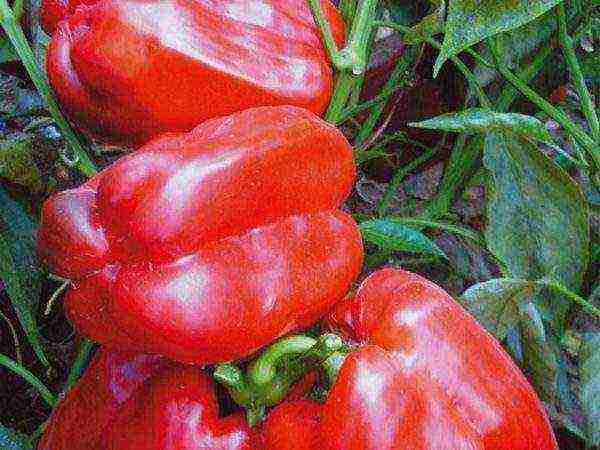 Pepper grade Tolstosum
Pepper grade Tolstosum
A new variety bred in Siberia. Resistant to cold, grows well in unprotected soil. Strong bush, up to 60 cm. Ripe red vegetable, large. The thick wall of the pulp tastes sweet and juicy.
Golden Taurus
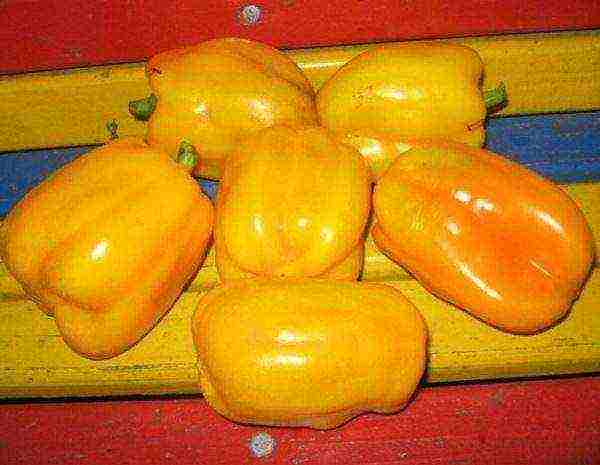 Siberian pepper variety Golden calf
Siberian pepper variety Golden calf
Medium early crop, well suited for growing in Siberia. Bushes of medium height. Fruits are orange, glossy, cuboid... The wall of the vegetable pulp is very thick, up to 20 mm.
Sweet chocolate
 Pepper grade Sweet chocolate
Pepper grade Sweet chocolate
Unusual due to its paint. The fruit is dark brown in color, while the flesh is red inside... The pepper is very juicy and sweet in taste, ideal for preservation.
Varieties for the Moscow region
For the changeable climate of the Moscow region, varieties should be selected that are resistant to a sharp change in temperature. The following are popular among gardeners:
gold medal
 Pepper grade Gold medal
Pepper grade Gold medal
High-yielding, can grow in unprotected soil. The bushes are high (up to 1 m). Fruits are straight, long (up to 13 cm) with an average wall thickness.
Belozerka
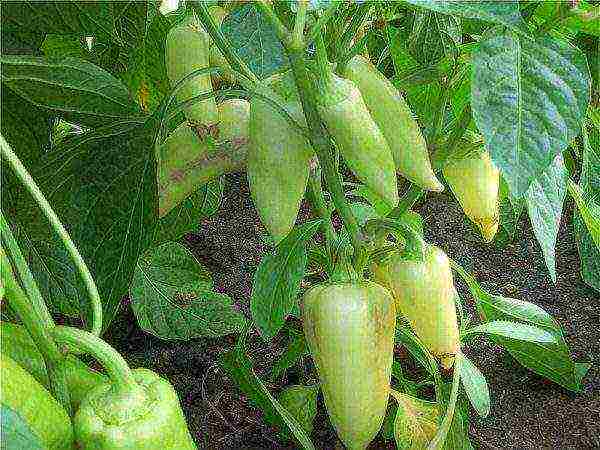 Sweet pepper grade Belozerka
Sweet pepper grade Belozerka
Belozerka is resistant to climate change and has a high yield. On low bushes (50-80cm) small cone-shaped hearths are formed... The color changes from light green to red towards the end of ripening.
Winnie the Pooh
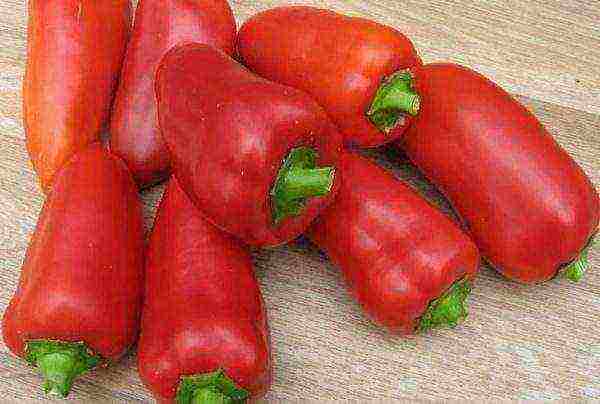 Pepper winnie the pooh
Pepper winnie the pooh
The bushes are low, suitable even for the smallest greenhouses. Winnie the Pooh Grows well outdoors. Fully ripens in 100 days. The fruits are small (10 cm), smooth, and have the shape of a sharp cone. The color of ripe pepper is bright red, the thickness of the flesh wall is 6 mm.
Gogoshary
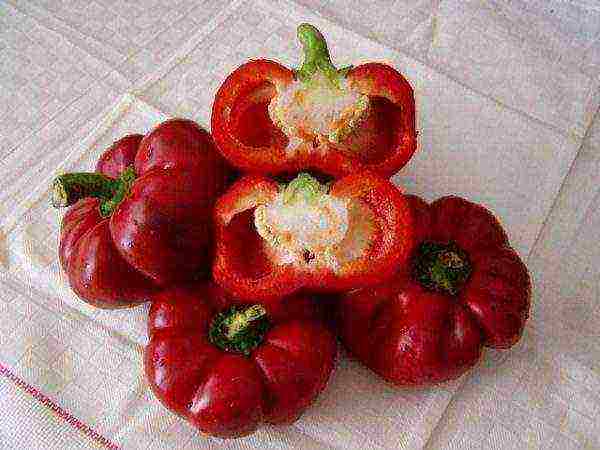 Pepper grade Gogoshary
Pepper grade Gogoshary
Medium early variety (95-100 days). It has an unusual flattened shape, reminiscent of a pumpkin. The bushes are tall, strong (up to 1 m). Fruits are thick-walled, fleshy, dark green at the beginning of ripening, deep red at biological maturity... It has an interesting sweet-spicy taste, good both fresh and after heat treatment.
The best hybrid varieties
The seeds of hybrid varieties are not suitable for further planting. therefore seedlings will have to be bought every year... But such qualities as high resistance to diseases, yield and impressive size of fruits make gardeners from year to year acquire exactly the seeds of hybrid plants.
Marinkin tongue
 Pepper grade Marinkin tongue
Pepper grade Marinkin tongue
Medium height plant, with rather large fruits (up to 200 g) of a long elongated shape... The taste is sweet, very pleasant, but the shelf life of these peppers is not long.
Triton
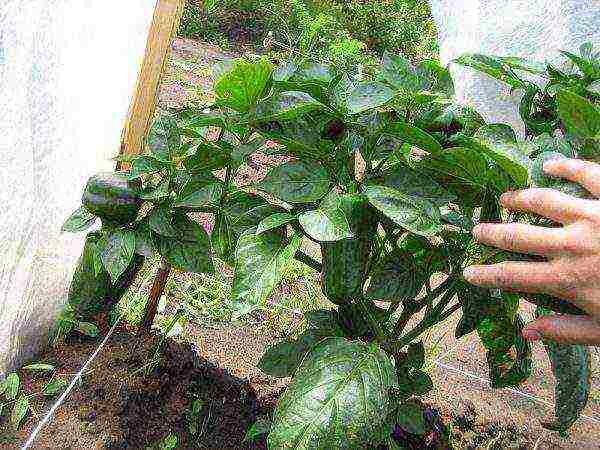 Extra early pepper Triton
Extra early pepper Triton
Incredibly high yield - more than 50 peppers can grow on one bush! The shape of the fruit is conical, the wall is not thick. The ripe fruit is bright red in color, ideal for processing.
Atlantic
 Hybrid pepper variety Atlantic
Hybrid pepper variety Atlantic
The classic representative of culture. Large fruits of bright red color, very juicy and aromatic... It is widely used for preparations and in fresh appetizers and salads.
Description of the best late-ripening peppers
Most suitable for southern latitudes, since they need 140-150 days with good weather to fully ripen.
Hercules
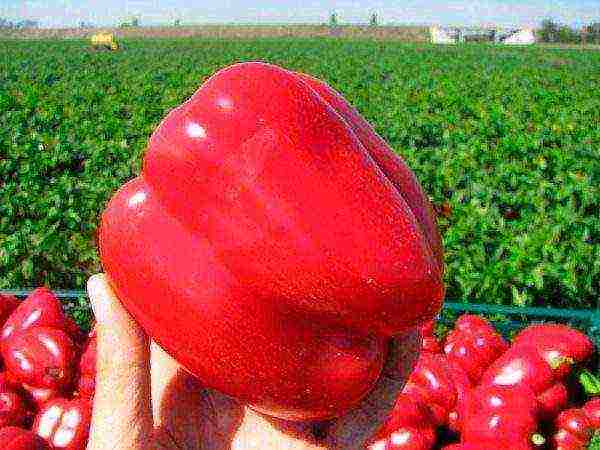 Pepper Hercules
Pepper Hercules
Stunted, has many large fruits. Ripe Hercules peppers are red, with thick juicy pulp.
Yellow bell
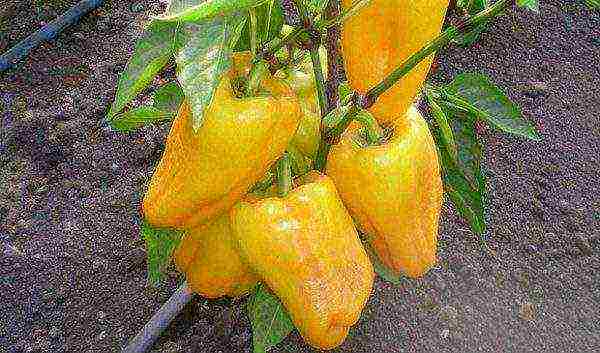 Pepper Yellow Bell
Pepper Yellow Bell
Plant of medium height (up to 75 cm) with large yellow-orange fruits when ripe. Shaped like an inverted bell... It has a thick flesh wall and excellent fresh taste.
Bogatyr
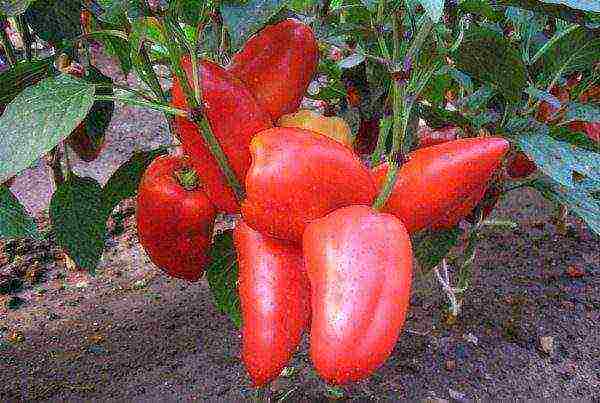 Pepper Bogatyr
Pepper Bogatyr
The hero is not afraid of open ground. Bushes are small, with large fruits. Ripe, cube-shaped pepper of bright red color with juicy pulp, has a great taste and aroma.
Marshmallow
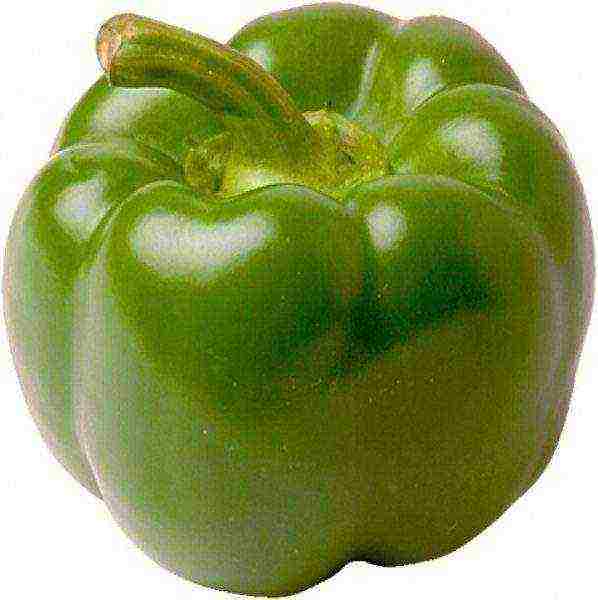 Pepper grade Marshmallow
Pepper grade Marshmallow
High yielding, vigorous plant (up to 80 cm) with a large number of globular fruits... The pulp is very juicy and sweet. The color changes from deep green to bright red.
Thick-walled large-fruited varieties
Wall thickness and fruit size is a decisive factor for most gardeners when choosing seeds. Thick-walled peppers are with a pulp thickness of 6mm. These varieties are great for canning, drying and freezing.
White gold
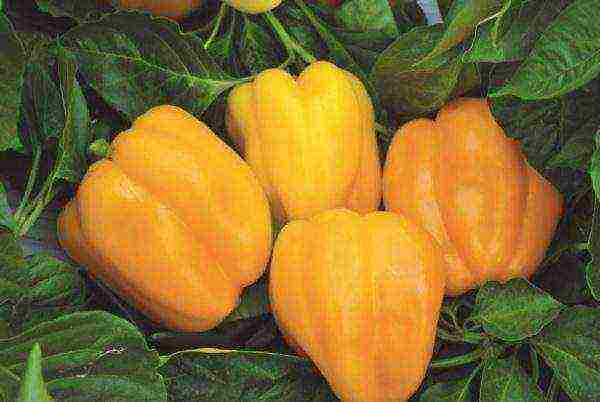 Pepper grade White gold
Pepper grade White gold
Can be planted in open ground. The plant is low, while with very large yellow fruits (up to 450g)... The peppers are cubic in shape.
Siberian format
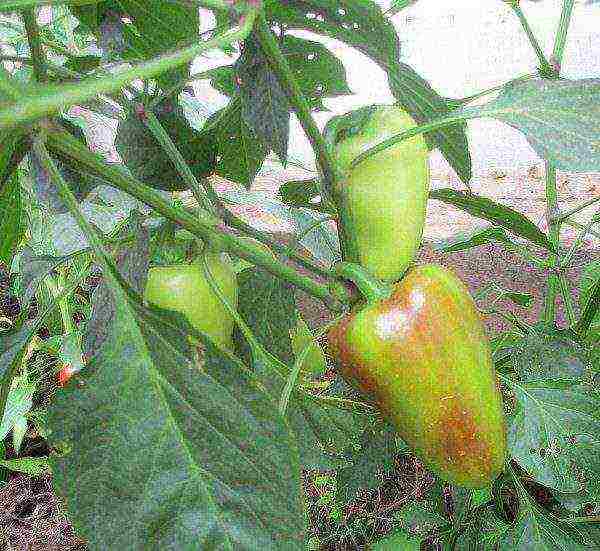 Sweet pepper variety Siberian format
Sweet pepper variety Siberian format
Mid-season, very large peppers grow on tall and powerful bushes. The size of the fruit grown in a greenhouse can be up to 500 g!
Queen
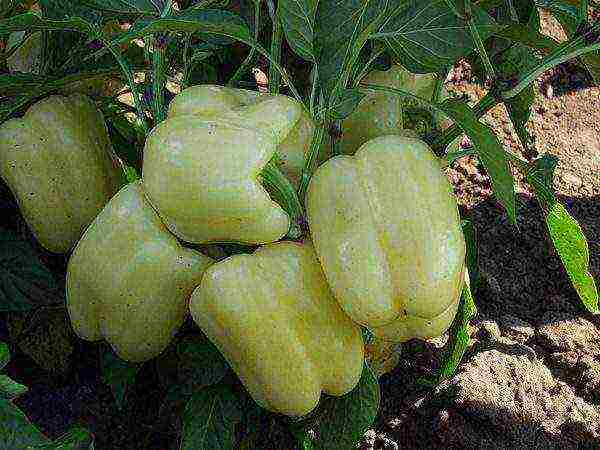 Sweet Pepper Queen
Sweet Pepper Queen
Fruitful, small fruit (up to 200g) has a thick ruby-red flesh. It perfectly tolerates long-term transportation.
The best peppers for stuffing and processing
Stuffing
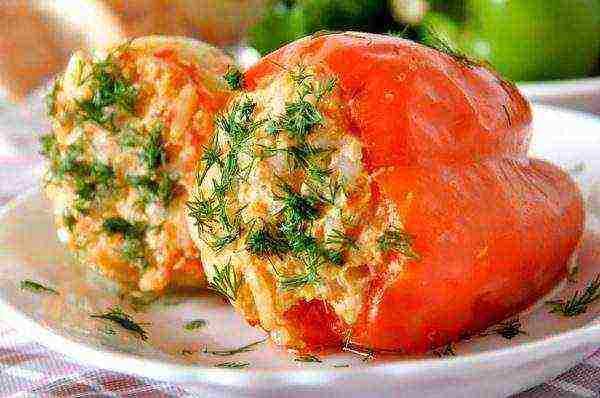 Stuffed bell pepper
Stuffed bell pepper
Pepper is ideal for food stuffing. For this, even, medium-sized peppers of the same size are usually used. Among the early ones it can be noted: Lyubava, Divo, Golden miracle, Banana, Marinkin tongue. Among mid-season: Antey, New Russian, Stepashka.
Drying
Long and elongated fruits are suitable for drying.... Sabelka and Miracle paprika are perfect for this. You can dry them directly in the fresh air.
Canning
 Canned bell peppers
Canned bell peppers
For preservation, it is ideal to use thick-walled fleshy varieties. And if you take several multi-colored peppers, the preparation will come out not only tasty, but also beautiful. Perfect for canning: Vanguard, Adept, Bogdan, Ideal, Lilac Bell, Chocolat Beauty, Amber.
Conclusion
Bell pepper is an unusually healthy, tasty and beautiful vegetable. It is grown in regions with different climatic conditions - Siberia, Moscow region, Donbass, Crimea and others. Thanks to the bright variety of colors and juicy fresh taste, it will always find a place on the festive table. And in terms of filling with vitamins, pepper is the leader among other vegetables. By eating just one pepper a day, you can replenish your daily supply of vitamins C and E. Bell peppers are called "the vegetable of beauty", because eating it improves the skin and strengthens the hair. Pepper is also good for the eyes, due to the high content of beta-carotene.
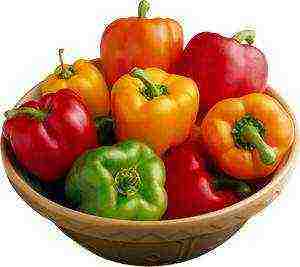 According to scientists, such a vegetable of our beds as sweet peppers, whose varieties allow you to get simply fantastic yields, deserves at least 3 gold medals among all vegetable crops: for the content of vitamin C, for vitamin A (carotene) and vitamin PP, which is generally very rare. Ascorbic acid (vitamin C) in it is 8-10 times more than in onions and tomatoes, twice more than in black currants and even lemons. And in sweet pepper, natural sugars, mineral macro- and microelements, B group vitamins, vitamin K and others accumulate in large quantities. All in all, this is the real king of outdoor vegetables. Here's a quick overview of the best modern sweet peppers.
According to scientists, such a vegetable of our beds as sweet peppers, whose varieties allow you to get simply fantastic yields, deserves at least 3 gold medals among all vegetable crops: for the content of vitamin C, for vitamin A (carotene) and vitamin PP, which is generally very rare. Ascorbic acid (vitamin C) in it is 8-10 times more than in onions and tomatoes, twice more than in black currants and even lemons. And in sweet pepper, natural sugars, mineral macro- and microelements, B group vitamins, vitamin K and others accumulate in large quantities. All in all, this is the real king of outdoor vegetables. Here's a quick overview of the best modern sweet peppers.
What are bell peppers?
 Over the past hundred years, scientists have managed to bring out more than a thousand varieties of this vegetable, which never cease to delight us with their shape, color and size. Even 30 years ago, all peppers were either cream or red, and now the color variety is simply amazing - from creamy white to almost black. There are varieties of sweet peppers with yellow, orange, lilac, purple, chocolate, two and three-colored fruits.
Over the past hundred years, scientists have managed to bring out more than a thousand varieties of this vegetable, which never cease to delight us with their shape, color and size. Even 30 years ago, all peppers were either cream or red, and now the color variety is simply amazing - from creamy white to almost black. There are varieties of sweet peppers with yellow, orange, lilac, purple, chocolate, two and three-colored fruits.
Modern pepper is also diverse in shape - standard cones, pyramids, rectangles and squares, balls in the form of turbans, bells, sabers - for every taste.
The sizes are also very different - from 50 to 600 grams, and there are champions with 800-1000 grams of fruits.
According to the intended purpose, the fruits are of the salad type, for canning, salting, freezing, drying and stuffing.
Thick-walled large-fruited varieties
 A very important quality of salad varieties is wall thickness. The best varieties of bell peppers with fleshy thick walls of large fruit are as follows:
A very important quality of salad varieties is wall thickness. The best varieties of bell peppers with fleshy thick walls of large fruit are as follows:
- American giant;
- California miracle;
- Bel Goy;
- Carlos;
- Ilyusha;
- Baron;
- Golden miracle;
- Fat man;
- Siberian format;
- Anastasia;
- Red giant;
- Bovine ear;
- Mastodon;
- Italian boot;
- Shorokshary;
- The sun of Italy.
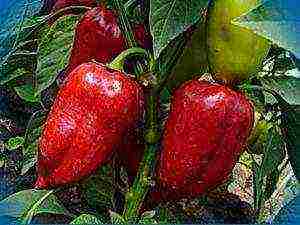 All of them are very tasty, and when ripe they can be stored for a long time. If you provide the right conditions, then you can feast on your peppers until the New Year and longer.These varieties for open ground are also great for freezing and for preparing lecho both in summer and in blanks for the winter. Among those listed, the earliest are the yellow-fruited Sun, Golden Pheasant and Heart of Italy, and the red ones (Anastasia, Kolokol) are mid-late varieties. The fruits of these varieties are from 250 to 500 grams, the wall thickness is 8-10 mm, the yield is 5-8 kg per bush.
All of them are very tasty, and when ripe they can be stored for a long time. If you provide the right conditions, then you can feast on your peppers until the New Year and longer.These varieties for open ground are also great for freezing and for preparing lecho both in summer and in blanks for the winter. Among those listed, the earliest are the yellow-fruited Sun, Golden Pheasant and Heart of Italy, and the red ones (Anastasia, Kolokol) are mid-late varieties. The fruits of these varieties are from 250 to 500 grams, the wall thickness is 8-10 mm, the yield is 5-8 kg per bush.
The best peppers for stuffing and processing
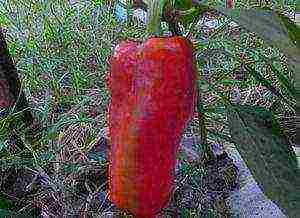 Pepper varieties for this purpose have a peculiarity - their fruits are medium-sized, leveled, ripen in several waves in large quantities. Among them there are very early varieties that give off the entire harvest in June-July, and there are those that ripen right up to the very frosts. The best varieties and hybrids for open ground:
Pepper varieties for this purpose have a peculiarity - their fruits are medium-sized, leveled, ripen in several waves in large quantities. Among them there are very early varieties that give off the entire harvest in June-July, and there are those that ripen right up to the very frosts. The best varieties and hybrids for open ground:
- Lyubava - all the fruits are one to one;
- Divo is an ideal variety for stuffing;
- Bogdan yellow-fruited - a variety for fresh consumption and in preparations;
- Golden miracle - yellow fruits grow in bunches, fruits look in all directions, the yield is amazing;
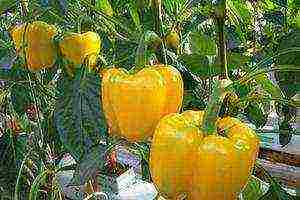 Golden shower - orange lined fruits;
Golden shower - orange lined fruits;- Red miracle - large oval fruits growing in tiers;
- Marinkin Tongue - long fruits with a curved tip, very sweet, walls up to 0.7 mm;
- Banana - bright narrow fruits up to 20 cm in length;
- Lyudmila is one of the best varieties for the market;
- Lemon miracle, etc.
And we will also list such varieties for open ground, early and late, long tested by our gardeners and summer residents: Aeneas, Antey, Triton, Cinderella, Marimba, Alba, New Russian, Marisha, Mavr, Stepashka.
These peppers have compact, but very powerful bushes, with beautiful foliage, fruits of different colors, with a wall thickness of 7-8 mm, a yield of about 4 kg per square meter.
Peppers for drying
 The best varieties for drying are the early, long (up to 30 cm!) Miracle paprika and Sabelka. They ripen before everyone else and go well in the first fresh salads. But their main application is drying, which is carried out directly in the sun. Two days are enough for complete drying. Then the peppers must be ground in a coffee grinder into a fragrant and very useful powder. Store in a tightly closed container in a cool place. It is an irreplaceable seasoning for borscht, soups, sauces.
The best varieties for drying are the early, long (up to 30 cm!) Miracle paprika and Sabelka. They ripen before everyone else and go well in the first fresh salads. But their main application is drying, which is carried out directly in the sun. Two days are enough for complete drying. Then the peppers must be ground in a coffee grinder into a fragrant and very useful powder. Store in a tightly closed container in a cool place. It is an irreplaceable seasoning for borscht, soups, sauces.
Sweet mini peppers
Recently, varieties have appeared on the seed market, the fruits of which are the same size as bitter peppers - up to 50 grams in weight, but very juicy and sweet in taste. There are so many of them on the bush that it looks like a Christmas tree. The best of this type for growing in the open field is the New Year's garlands variety. In cans, it looks amazing, it can be added whole to salads and as a side dish for meat.
Pepper bed favorites
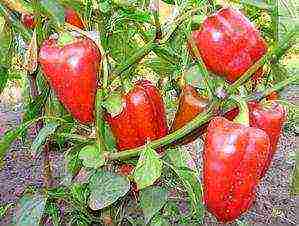 It is simply impossible to describe all the huge variety of varieties. We will focus on those varieties that were recognized by the leading gardeners as the best in past seasons in terms of yield, resistance to disease and the vagaries of the weather, as well as taste.
It is simply impossible to describe all the huge variety of varieties. We will focus on those varieties that were recognized by the leading gardeners as the best in past seasons in terms of yield, resistance to disease and the vagaries of the weather, as well as taste.
- Lemon miracle. Early ripe variety, bush up to 60 cm in height. Fruits are yellow-orange, smooth, even, 180-200 grams. Well tolerates unfavorable growing conditions, tasty, excellent for canning in any form.
- Fat man. Mid-season variety, up to 50 cm high. Fruits are cuboid, thick-walled - 0.8 mm, bright red, with a mild harmonious taste.
- Siberian bonus. Medium ripening, small bush - up to half a meter. Fruits 200-300 grams, dark orange, glossy, cuboid, wall up to 1.2 mm! The variety is included in the cohort of the best in the world - enviable size, rare color, unsurpassed taste combined with a delicate pulp consistency.
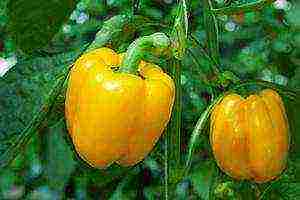 Hercules. Mid-season variety with dark red cuboid fruits. Fruit weight up to 350 grams, walls up to 1 cm. The pulp is juicy, with a pronounced peppery taste. There are so many fruits that the bushes can break off under their weight - it is recommended to tie the branches to the pegs.
Hercules. Mid-season variety with dark red cuboid fruits. Fruit weight up to 350 grams, walls up to 1 cm. The pulp is juicy, with a pronounced peppery taste. There are so many fruits that the bushes can break off under their weight - it is recommended to tie the branches to the pegs.- White gold. One of the earliest varieties. The bush is undersized - 40 cm, pearl-yellow fruits, weighing 300-400 grams, juicy, aromatic, with a mildly spicy taste. A variety of universal use.
- Siberian format. Medium-sized bushes up to 70 cm high. Fruits are red, cuboid, weighing 350-500 grams, walls up to 1 cm, the taste is amazing.
- The sun of Italy. A medium-ripening variety, a small bush - up to 50 cm in height. Fruits are prismatic, lemon-orange in color, very large. Reach weights up to 500-600 grams with good care. Very juicy and sweet. An excellent variety for commercial cultivation. Resistant to most pepper diseases.
 Shorokshary. One of the best Moldovan varieties, has a number of international awards. The bush is 40-50 cm high, each with up to 20 huge cone-shaped fruits. At the same time, there are green, yellow and red-orange fruits on the bush. The taste is very pleasant. Ideal for making lecho and canned salads.
Shorokshary. One of the best Moldovan varieties, has a number of international awards. The bush is 40-50 cm high, each with up to 20 huge cone-shaped fruits. At the same time, there are green, yellow and red-orange fruits on the bush. The taste is very pleasant. Ideal for making lecho and canned salads.- Bovine ear. One of the best peppers to taste. Bush 70-80 cm, fruits are red, long, conical. Wall thickness 1 cm, bears fruit until frost.
- Health. A high-yielding, multi-fruited variety from the earliest. All his fruits seem to be calibrated - they weigh about 100 grams. Ideal for stuffing and preforming. It is included in the TOP-10 in terms of vitamin C.
- Alba. A unique variety of Moldovan selection with a thick, juicy wall, perfectly tolerates heat. Stored for a very long time. Amazing productivity. With proper care, it can give up to 8 kg per 1 sq. meter of landings. The bush is low - about 50 cm.
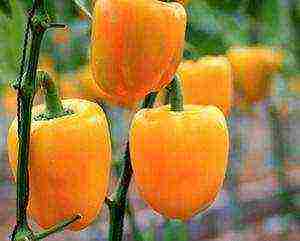 Belozerka. This variety is called a hard worker, as it gives stable yields regardless of the vagaries of the weather. Differs in unpretentiousness, suitable for cultivation in the southern and northern regions. Very attractive in appearance - already at the stage of technical ripeness, the fruits of a very beautiful yellow color, with a pleasant taste. The fruits are large and one-dimensional.
Belozerka. This variety is called a hard worker, as it gives stable yields regardless of the vagaries of the weather. Differs in unpretentiousness, suitable for cultivation in the southern and northern regions. Very attractive in appearance - already at the stage of technical ripeness, the fruits of a very beautiful yellow color, with a pleasant taste. The fruits are large and one-dimensional.- Anastasia. The dark cherry fruits of this unique heart-shaped variety are more like tomatoes and are just as tasty, sweet, aromatic, thick-walled. This variety can be grown even in flowerpots on the balcony - an excellent harvest is guaranteed.
- Carpathia. Tall bush - up to 1 meter, light fruits with golden tint, up to 20 cm long, even, smooth, very tasty.
 Golden jubilee. Early, high-yielding, cuboid-shaped fruit, smooth, bright orange, weight 140-150 grams. The walls are of an average thickness of 0.7 mm. The height of the bush is about 70 cm, the crown is large.
Golden jubilee. Early, high-yielding, cuboid-shaped fruit, smooth, bright orange, weight 140-150 grams. The walls are of an average thickness of 0.7 mm. The height of the bush is about 70 cm, the crown is large.- Bel Goy. The best of large-fruited peppers with elongated cuboid fruits weighing up to 400 grams, with an excellent peppery taste. Shrub up to 1.2 m. We recommend buying seeds only in company stores, since there are no varietal seeds in the markets.
Be sure to grow bell peppers in your garden, because they are not only tasty and beautiful, but also have medicinal properties. There is nothing more useful than natural vitamins.
We all love peppers. They are extraordinary - large, cuboid, sweet, with thick walls. wants to advise what is the best to choose sweet pepper seeds for planting, so that tasty and fragrant fruits grow.
In central Russia, the cultivation of peppers is possible only by seedling, since the ripening period for peppers is longer than our summer, therefore, early and mid-early varieties of sweet peppers are interesting.
Agrofirms that are engaged in the development of new varieties of pepper and seeds, such as Gavrish, SeDek, recommend planting not varieties, but hybrids of pepper.
What is the difference between a hybrid and a cultivar?
The variety is the result of selection. All his genes, the same and like two peas in a pod, are similar to their parents. The variety is selected and adapted to a specific climate and place. When pollinated, it produces seeds of the same variety. You can get seeds from the variety. For this, the most characteristic and best fruits are selected from the most developed bushes.
A hybrid is the result of crossing. The effect is obtained by a certain combination of parents. Hybrids are far superior to their parents in terms of growth and yield, sometimes showing very unique properties. But it is impossible to get seeds from them, most often they will look like unremarkable grandparents.
It is very simple to distinguish a pepper variety from a hybrid. The hybrid bag will say F1. This means that it is a hybrid in the first generation.
The best varieties of sweet peppers
+ read an article about the best varieties of pepper for the Moscow region
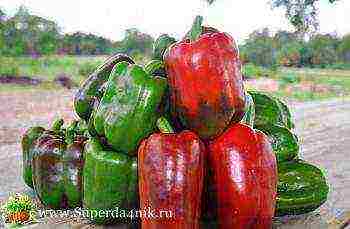
Pepper varieties for planting
California miracle
If you still decide to plant exactly the varieties of sweet peppers, then this may be a California miracle. Early pepper, 100-130 days pass from the emergence of seedlings to technical ripeness. The plant is determinant. Bears fruit for a long time, the fruits are large, cuboid, thick-skinned (wall thickness 6-7 mm) and fragrant. Peppers grow weighing 80-130 g. From this variety you can get seeds, germination rate is 100% and you will have your best varieties of sweet peppers. Can be used fresh and canned.
What they say about pepper California miracle reviews
- I have been studying for a very long time which seeds are better to buy for our middle lane lands. Not all sprout or die during night frosts. I opted for two varieties, one of which was the "Californian miracle". The germination of pepper did not produce any special emotions, everything went as usual, maybe a little more water is required at the stage of the appearance of the first flowers than ordinary seedlings. But at the landing stage, everything went much better than usual. Out of 10 planted plants, 9 plants took root in the ground (this is when you consider that I used special soil for seedlings, which, in general, is wrong) 9 pieces. The tenth also resisted for a long time, but my fault was not to look after him. Then everything went like clockwork, in the sense of like pepper. Leaves, beautiful flowering and fruit. I was very pleased with the taste of the fruit: sweet, aromatic, pleasant. Ideal for all kinds of workpieces. Already winter has passed almost, and pepper still pleases with its presence on the table at dinner, it turned out a lot! I advise everyone to pepper California miracle _ this is an excellent Bulgarian pepper variety for central Russia, it takes root well and bears fruit well! The fruits are strong, tasty, grow abundantly! Have a nice garden to everyone!
- For many years she has been growing the "California Miracle" pepper. This reliable variety produced yields even outdoors in Siberia. This is a fruitful sweet pepper variety for Siberia. One drawback: the thinness of the fruit, but apparently this is due to the lack of sunny days and warmth.
Cow's ear
This is a mid-early variety, from the moment of planting seedlings to fruiting, 70 -75 days pass. These are hybrids and varieties of peppers for the polycarbonate greenhouse and for outdoor use. They grow short, the bushes are about 60 - 70 cm in height, so they can be grown under film shelters.
The fruits grow juicy, tasty, weighing 120 - 150 grams, retain their appearance well and are easily transported. An elongated variety of bell pepper, the average length of the fruit is 10 - 12 cm with thick walls. Refers to thick-walled peppers.

Pepper Volovye ear reviews of gardeners:
- My first peppers, Volovye's ear, grew in length up to 40 cm. Then they began to shrink, to about 8 - 12 cm, but the first ones just hit me. Delicious and aromatic!
Gemini F1 yellow sweet pepper hybrid
These Dutch pepper seeds are best for outdoor use as they do not grow tall. Bushes about 60 cm in height, can grow well under film shelters.
Highly productive early varieties of sweet pepper. They can even be called very early ripening, since the fruits begin to ripen 72-78 days after transplanting. Fruits are large, cuboid-elongated, four-chambered, from dark green to bright yellow, have high taste. They perfectly tolerate stress and are resistant to sunburn, air drought. These are the beautiful best varieties of peppers for outdoor use. They grow on a long stalk, so they are easy to pick when harvesting.
Pepper Gemini F1 reviews:
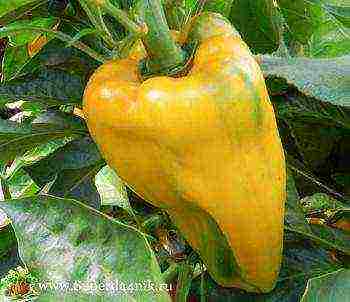
Bell pepper Claudio F1
It is a high-yielding Dutch line sweet pepper hybrid that can be grown:
- in the open field,
- in film greenhouses,
- glass greenhouses,
- in polycarbonate greenhouses.
Pepper Claudio F1 is early ripe, the first peppers begin to ripen 72-80 days after planting seedlings in open ground or in a greenhouse. This Bulgarian pepper seed of the best varieties has a cuboid - elongated fruit. Peppers are dark green at technical maturity, and then turn to dark red. Very tasty and aromatic, weighing about 200 grams. Peppers, subject to growing technology and a sufficient amount of heat and sun, grow thick-walled, wall thickness 10-14 mm.
Pepper claudio F1 reviews of gardeners:
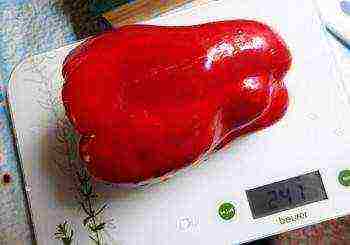
- It turned out rather late, I did not blush for a very long time. But perhaps because of the cold, rainy summer. Grew up in open ground, without shelter. She covered it only in August, so that the fruits would turn red faster. I liked the taste - sweet, juicy. The wall thickness was 8-10 mm. The fruits were all the same size, but small on the bush. Perhaps in a greenhouse or in the exhaust gas under normal weather conditions it would have performed better. Germination rate is 100% - from 5 seeds all five germinated.
- I'm a beginner. Planted pepper seeds variety Claudio F1 (Holland) written supernova 2010 50 pieces 12.02., Ascended 19.02 all to one, stand like soldiers, handsome (ugh, ugh). I bought seeds not in the store but directly from the Semko firm. So there I received recommendations for planting that seeds purchased from serious companies are not soaked, this applies not only to peppers. And tomatoes and cucumbers ... I planted everything and everything sprang up quickly and amicably. Last season I bought seeds in stores - there were a lot of tears.
- That year I planted 5 Gemini F1 and Claudio F1 plants each - the harvest was excellent, this year I plant 10 bushes each.
The best varieties of peppers for 2018
In 2016, it is best to plant proven varieties of peppers. They always show themselves very well both in seedlings and in yield:
- Claudio F1 is a very productive, early, large pepper hybrid.
- Gemini F1 - large, sweet.
- Hercules - cuboid, medium ripening,
- Samander - early, fruitful, fruits were removed until late autumn, canonical form.
- Cockatoo - harvested outdoors, tasty, sweet fruit.
- Bogatyr - medium ripening, peppers all grow even.
New varieties and hybrids of pepper seeds
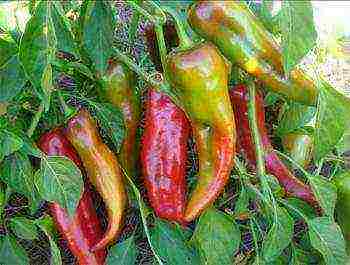
Samander F1
Manufacturer "Sortsemovosch":
- Patricia F1 - medium ripening, high 130 cm, large, cuboid, yellow,
- Santia F1 - height 120 cm, large, conical, red, disease resistant,
- Viking red and Viking yellow - height 110 cm, early, very tasty saber-shaped fruits.
The manufacturer "Sedek" has released abundant varieties of small-fruited peppers for whole canning:
- Black sugar,
- Mother-in-law's tongue.
Seed producer "Poisk":
- Atlas - height 70 cm, very early, red, thick-walled.
From the early ripening hybrids of bell peppers - Apollo, Bonus, Kakadu, Marya, Pygmalion, Shuttle. Early ripe pepper varieties - Jack, Dawn, Irene, Mavr, Mirage, Peacock.
Excellent sweet peppers from the Star of the East series are hybrids of very different colors: yellow, golden, brown, purple, white. All thick-walled, large, early or medium-early, brightly colored.
New varieties of hot pepper:
- Dagger,
- hybrid Lightning,
- hybrid Gorgon.
Which pepper is better to plant, according to gardeners:
- Bulgarian 79. Sweet pepper. Medium early high-yielding variety for open ground and film greenhouses.
- Bouquet of the East F1. Semi-sharp. Mid-early hybrid for open ground and film shelters.
- Star of the East Violet F1. Sweet pepper. Medium-early high-yielding hybrid for open and protected ground.
- Igalo F1. Sweet pepper, yellow. Designed for growing in all types of greenhouses.
- Kazbek F1. Hybrid for film greenhouses and open ground in the southern regions.
How to grow peppers: infographics

Click on the picture to enlarge
Rate the quality of the article. We want to be better for you:
Sweet pepper is a southern sissy, so special conditions should be created for its cultivation. Greenhouse - film or glass - what you need! And we will help you decide which varieties to give preference to.
It would seem, why should a plant be afraid in a greenhouse? However, when growing crops in greenhouses, you need to understand that the slightest non-observance of agricultural technology can negate all the advantages of the variety. We offer you the top of the best varieties and hybrids, the breeders have worked hard to improve the characteristics of.
1. Apricot favorite
An early ripe sweet pepper variety has a consistently high yield. Designed for growing in a greenhouse, however, many gardeners are very successful in planting it in open ground. The bush is undersized, only 40-50 cm high. Fruits are conical in shape, and smooth and shiny in appearance, with a wall thickness of 7 mm. During the period of technical ripeness, peppers are light green, biological - bright orange.
Many people fell in love with this variety due to, although not large, but very juicy fruits. The apricot favorite is great for both fresh consumption and canning.
| Appointment | Growing | Ripening period (days) | Fruit weight (g) | Productivity (kg / sq.m) |
| 100-120 | 100-120 | 10-20 | ||
2. Agapovsky
High-yielding early ripening variety. A compact, medium-sized bush reaches a height of only 60-80 cm. Fruits are rather large, smooth, slightly ribbed, prism-shaped. In the period of technical ripeness, they are dark green, biological - bright red. The wall thickness of the pepper is 5-7 mm.
Gardeners note that the variety is susceptible to damage to the fruit by apical rot, but it is very resistant to the tobacco mosaic virus.
| Appointment | Growing | Ripening period (days) | Fruit weight (g) | Productivity (kg / sq.m) |
| 99-120 | 114-120 | 10-13 | ||
3. Atlant F1
A mid-season, highly productive sweet pepper hybrid. Since the plant does not exceed 80 cm in height, it is ideal for growing in low-rise plastic greenhouses. The shape of the fruit is elongated, conical, it looks glossy, in the period of technical ripeness it is colored green, ripening, it becomes bright red. Wall thickness 4-5 mm.
Fans of Atlant pepper note its excellent taste, juicy pulp and pronounced aroma - the fruits are good to eat fresh and harvested. The hybrid is "not afraid" of viruses of tobacco and potato mosaic, moreover, it tolerates unfavorable weather conditions quite successfully.
| Appointment | Growing | Ripening period (days) | Fruit weight (g) | Productivity (kg / sq.m) |
| 120-125 | 180-190 | 10-20 | ||
4. Belladonna F1
Very early ripening sweet peppers. Ideal for growing in glass and film greenhouses. Some summer residents successfully grow a hybrid in the open field. The height of a medium-sized compact bush is 60-80 cm. The color of the fruit at the stage of technical ripeness is greenish-white, biological - light yellow. The fruits are cuboid in shape, glossy in appearance, smooth. Wall thickness 5-7 mm.
The hybrid is highly resistant to the tobacco mosaic virus.
| Appointment | Growing | Ripening period (days) | Fruit weight (g) | Productivity (kg / sq.m) |
| 80-90 | 140-160 | 10-15 | ||
5. Bogatyr
A mid-season high-yielding variety bears this name by right. The height of a powerful sprawling bush is 50-70 cm. The color of the fruit at the stage of technical ripeness is light green, biological - deep red. It is conical in shape with a wall thickness of 5-7 mm.
Vegetable growers appreciate the Bogatyr variety not only for its constant yield, but also for its good resistance to fungal infections and verticillary wilt, as well as for its cold resistance. In addition, the fruits of the variety not only tolerate transportation well over long distances, but are also well stored.
| Appointment | Growing | Ripening period (days) | Fruit weight (g) | Productivity (kg / sq.m) |
| 125-135 | 150-180 | 10-20 | ||
6. Star of the East chocolate F1
An early ripe hybrid of sweet pepper. A powerful, branchy bush of the plant reaches a height of 70 cm.The fruits are large, glossy, cylindrical in shape. The color of the fruit in the period of technical ripeness is dark green, biological - dark brown. Wall thickness - 10 mm.
Vegetable growers note the pronounced sweet taste and juicy pulp of this hybrid. But they love him not only for this. The chocolate star of the East from year to year gives a high yield (from 8 to 10 kg per 1 sq. M), pepper also has a good keeping quality and immunity to diseases.
| Appointment | Growing | Ripening period (days) | Fruit weight (g) | Productivity (kg / sq.m) |
| 95-105 | 260-350 | 10 | ||
7. Isabella F1
A mid-season and very high-yielding sweet pepper hybrid. Suitable for growing both indoors and outdoors. A powerful but compact bush reaches a height of 60 cm. Fruits are prismatic with a wall thickness of up to 10 mm. In the technical phase, they are green, in the biological phase, they are bright red.
The pulp of the pepper is sweet and juicy, with a bright peppery aroma. The hybrid is unpretentious in growing and tolerates transportation well.
| Appointment | Growing | Ripening period (days) | Fruit weight (g) | Productivity (kg / sq.m) |
| 120-125 | 130-160 | 10-13 | ||
8. California miracle
One of the most popular mid-early peppers. The bush is low, about 70 cm. Fruits are cuboid, seemingly smooth and glossy. During the period of technical ripeness - green, biological - red. Wall thickness 4-5 mm. The California miracle is truly a miracle: the aroma of fresh fruits is so strong that you just want to eat them immediately, right from the garden. However, pickled ones are just as beautiful!
The cultivar has shown itself to be resistant to the tobacco mosaic virus. However, not every gardener is able to harvest a rich harvest every year, since not all soil is suitable for this variety. In addition, it is extremely important to observe the feeding regime. The California miracle reacts poorly to excess nitrogen fertilizers. Although the plant becomes more powerful from them, the fruits are tied worse.
| Appointment | Growing | Ripening period (days) | Fruit weight (g) | Productivity (kg / sq.m) |
| 100-129 | 80-128 | 10 | ||
9. Cardinal F1
This ultra-early ripening hybrid is intended for cultivation in greenhouse conditions. Since the bush of the plant is quite high - up to 1 meter, you will have to find a higher greenhouse so that the Cardinal feels comfortable, and nothing prevents him from developing. The fruits of the hybrid are cuboid, very large, as evidenced by their mass - 250-280 g. During the period of technical ripeness, they are green, when ripe they become dark purple, as well as fleshy and very juicy. Wall thickness Cardinal pepper 8 mm.
Vegetable growers receiving a stable high yield note that the hybrid is very resistant to the tobacco mosaic virus.
| Appointment | Growing | Ripening period (days) | Fruit weight (g) | Productivity (kg / sq.m) |
| 80-90 | 250-280 | 10-20 | ||
10. Swallow
An early ripe sweet pepper variety. Recommended for cultivation in film greenhouses and in the open field. The plant is of medium height - 48-60 cm. Fruits are oval, conical, smooth. In the phase of technical ripeness, they are light green, biological - red. Wall thickness 6-7 mm.
The swallow is relatively resistant to verticillary wilt. Gourmets prefer to use fresh pepper, but it is also very suitable for canning. The fruits of the variety are well kept and tolerate moving well.
| Appointment | Growing | Ripening period (days) | Fruit weight (g) | Productivity (kg / sq.m) |
| 106-130 | 80-100 | 10-15 | ||
Many of the varieties we have proposed have passed the "strength test" and have shown themselves to be high-yielding, resistant to unfavorable climatic conditions, many diseases and pests. Perhaps you have your own developments - varieties that have shown themselves "in all their glory." Tell us about them in the comments.

